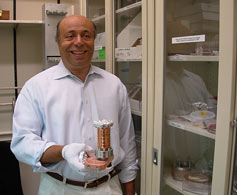
Handy Links
SLAC News Center
SLAC Today
- Subscribe
- Archives: Feb 2006-May 20, 2011
- Archives: May 23, 2011 and later
- Submit Feedback or Story Ideas
- About SLAC Today
SLAC News
Lab News
- Interactions
- Lightsources.org
- ILC NewsLine
- Int'l Science Grid This Week
- Fermilab Today
- Berkeley Lab News
- @brookhaven TODAY
- DOE Pulse
- CERN Courier
- DESY inForm
- US / LHC
SLAC Links
- Emergency
- Safety
- Policy Repository
- Site Entry Form

- Site Maps
- M & O Review
- Computing Status & Calendar
- SLAC Colloquium
- SLACspeak
- SLACspace
- SLAC Logo
- Café Menu
- Flea Market
- Web E-mail
- Marguerite Shuttle
- Discount Commuter Passes
-
Award Reporting Form
- SPIRES
- SciDoc
- Activity Groups
- Library
Stanford
Around the Bay
Pushing for Higher Gradients
 Like a boxer eating calorie-dense foods to get to the top of his weight class before a match, particles pumped up on high acceleration gradients pack more power into every collision.
Like a boxer eating calorie-dense foods to get to the top of his weight class before a match, particles pumped up on high acceleration gradients pack more power into every collision.
A new collaboration, hosted by SLAC, is working on ways to boost acceleration gradients—the measure of how quickly particles amass energy—to unprecedented levels.
The U.S. Collaboration on High Gradient Research for Future Colliders began almost a year ago. Already, the program has tested klystrons and developed prototype accelerator cavities that can add more than 100 mega-volts of energy per meter (MV/m) to a bunch of particles. The goal is to develop gradients of 100 to 200 MV/m. In contrast, SLAC's linac has a gradient of about 17 MV/m, and the proposed International Linear Collider hopes to achieve up to 35 MV/m.
The collaboration's test facilities include the Klystron Test Lab and Next Linear Collider Test Accelerator here at SLAC, as well as facilities at MIT, Argonne National Laboratory, Yale, the Naval Research Laboratory, KEK in Japan and CERN in Europe. The collaboration also includes the University of Maryland and Lawrence Berkeley National Laboratory.
"We're looking for innovation in geometry, materials, surface processing and novel acceleration concepts," said Collaboration Head and SLAC Associate Professor Sami Tantawi.
In the Klystron Test Lab, researchers are taking advantage of unique klystrons that operate at X-band frequency (11.4 gigahertz). Originally developed at SLAC for the future linear collider before the project turned to superconducting technology, the klystrons now boast a new pulse compression system that quintuples the energy of the microwave pulses created in the klystron.
To accelerate particles, the high-energy microwaves race from the klystron to one-cell test cavities—abbreviated versions of the waveguide, or pipe, through which particle beams travel. This setup has reached gradients greater than 100 MV/m. However, Tantawi emphasized that these cavities are not yet ready to be scaled up into working devices.
There are two major limitations on how much energy can be pumped into an accelerator cavity: the high surface electric fields and the high surface magnetic fields that come from higher power microwaves. Under high magnetic fields, the cavity material quickly cycles between hot and cold, creating cracks in the material after a few weeks of operation. Researchers are using a novel, reusable cavity to test both superconducting and normal conducting materials for their strength under high magnetic fields.
One of the collaboration's breakthroughs is a geometrically graceful piece of copper that changes the magnetic field pattern at the front of the cavity, thereby reducing stress on the cavity material.
In addition to magnetic fields, researchers must understand the effect of very high surface electric fields. If this field becomes too strong, it can rupture the surface of the cavity.
"Our goal is to understand the physics. We know it’s tied to the geometry of the material," Tantawi said.
The research is going very well, added Juwen Wang, who has been designing accelerator cavities at SLAC for more than 25 years, beginning with his PhD research on high-gradient issues. "SLAC is a unique place for this kind of research. We have the history, and now we can provide very high power microwaves and versatile facilities for this world class research."
—Heather Rock Woods, SLAC Today, July 13, 2007
Above image: Sami Tantawi holds a test cavity designed at SLAC and built at KEK that will soon be tested here for its ability to sustain high acceleration gradients. (Click on image for larger version.)